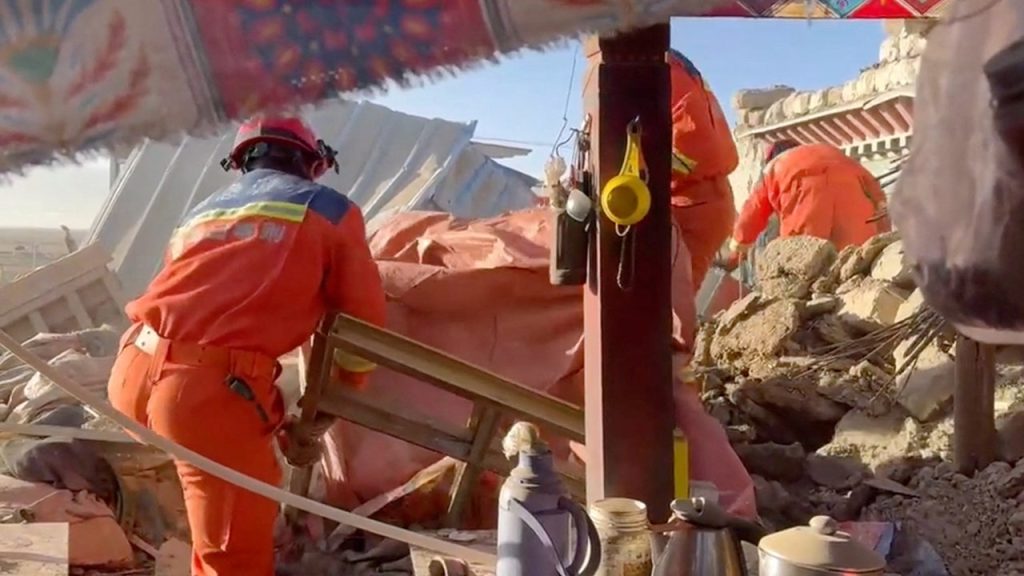Paragraph 1: The Devastating Earthquake and Initial Impact
A powerful 7.1 magnitude earthquake struck the Tibet region on Tuesday, leaving a trail of destruction and loss of life. The epicenter, located approximately 50 miles from the iconic Mount Everest, unleashed its force at a relatively shallow depth of six miles, amplifying the impact on the surface. Initial reports indicate at least 95 fatalities in Tibet and over 130 injuries on the Chinese side of the border, with figures expected to rise as rescue efforts continue. The quake’s devastating power left more than 1,000 homes damaged or destroyed, transforming once-vibrant villages into landscapes of rubble and debris.
Paragraph 2: Rescue and Relief Efforts
Immediately following the quake, a massive rescue operation was launched, with over 3,000 rescuers deployed to the affected region. Rescue workers faced daunting challenges, navigating treacherous terrain littered with broken bricks and collapsed structures. Videos emerging from the disaster zone depict rescuers carefully carrying survivors on stretchers through the debris-strewn streets. The primary focus remains on locating and extricating those trapped beneath the rubble, providing medical assistance to the injured, and offering support to the affected communities. The high altitude of the region, averaging 13,800 feet, adds another layer of complexity to the rescue efforts.
Paragraph 3: Impact Beyond the Epicenter
The earthquake’s impact extended beyond the immediate vicinity of the epicenter. Tremors were felt as far away as Kathmandu, the capital of Nepal, located approximately 140 miles from the quake’s origin. The shaking woke residents in the early morning hours, sending them fleeing their homes in fear. While Kathmandu was spared the level of devastation witnessed closer to the epicenter, the incident served as a stark reminder of the region’s vulnerability to seismic activity.
Paragraph 4: Geological Context and Aftershocks
The U.S. Geological Survey confirmed the earthquake’s magnitude as 7.1, classifying it as a major earthquake capable of widespread damage. The relatively shallow depth of the quake further intensified its impact on the surface. In the hours following the main shock, approximately 50 aftershocks were recorded, adding to the anxiety and uncertainty in the region. These aftershocks pose a continued threat of further damage to already weakened structures and can hinder rescue operations. Authorities closed the Mount Everest scenic area on the Chinese side as a precautionary measure.
Paragraph 5: Scope of the Disaster and Population Affected
The earthquake’s impact is concentrated in a region encompassing three townships and 27 villages within a 12.5-mile radius of the epicenter on the Chinese side. According to state media, approximately 7,000 people reside in this area, making them directly vulnerable to the quake’s destructive force. The remote and mountainous terrain presents logistical challenges for delivering aid and providing essential services to the affected communities.
Paragraph 6: Eyewitness Accounts and Media Coverage
Eyewitness accounts and videos captured the immediate aftermath of the earthquake, conveying the fear and chaos that ensued. A video from Kathmandu, obtained by the Associated Press, shows water sloshing out of a pond in a courtyard, a visual representation of the ground’s violent shaking. A woman’s voice can be heard expressing the shared sentiment of the moment: "It is a big earthquake. People are all shaking." News agencies and media outlets around the world are closely monitoring the situation, providing updates on the rescue efforts and the evolving impact of this devastating natural disaster. The international community is also mobilizing to offer assistance and support to the affected regions.

